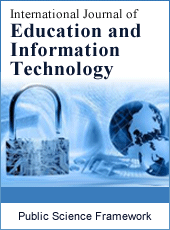International Journal of Education and Information Technology
Articles Information
International Journal of Education and Information Technology, Vol.1, No.4, Oct. 2015, Pub. Date: Sep. 26, 2015
Relationship Between Knowledge Management and Organizational Memory in Islamic Azad University
Pages: 139-147 Views: 3722 Downloads: 2258
[01]
Hadi Rezghi Shirsavar, Department of Educational Management, College of Education and Psychology, Garmsar Branch, Islamic Azad University, Garmsar, Iran.
The main goal of this research is providing a model to explain the relationship between elements of management’s knowledge and organizational memory in private higher education of the country. The following research is correlated from the view point of the applied purpose and implementation method of measurement. Data collection instruments includes researcher’s questionnaire made of 33 accents. Structural analysis of the research was confirmed as the formal validity and the reliability of the research tools used was obtained 0.837 was obtained. Statistical Society of this research includes all non-faculty employees of the Islamic Azad university eight regions, who were selected on the basis of the cluster-random sampling and according to Morgan table, which included 378 people considering the whole size of the population. Results of regression testing has been demonstrated to provide a model, on the first place for the components which created opportunities to apply knowledge, on the second for the knowledge organization, on the third for knowledge creation and on the fourth place for components of knowledge collection and supply.
Organization, Knowledge, Knowledge Management, Organizational Memory, Islamic Azad University
[01]
Adams, G. L., & Lamont, B. T. (2003). Knowledge management systems and developing sustainable competitive advantage. Journal of Knowledge Management, 7(2), 142-154.
[02]
Anand, v & others. (1998) organizational memory approach to information management. academy of management review, 23(4), 796-809.
[03]
Butler, t. (2003). from data to knowledge and back again. The journal of corporate transformation, 10(41), 144-155.
[04]
Dooley, K. J., Corman, S. R., & McPhee, R. D. (2002).A knowledge directory for identifying experts and areas of expertise. Human Systems Management, 21, 217-228.
[05]
Emiris, M. Dimitrios & others (2004); Towards a holistic knowledge management model, journal of knowledge management, vol, 8, P: 32-46.
[06]
Feliciano, Joe L (2006); The Success Criteria for Implementing Knowledge Management Systems in an Organization, Doctor of Philosophy thesis Pace University September.
[07]
Giraldo, Gloria Lucía, Giraldo, Germán rrego (2007) Organizational Memory for Knowledge and Information Management in the Definition, Analysis and Design Phases of Civil Engineering Projects using an XML Model, available on: www.Springerlink.com.
[08]
Hansen, M.T. (Ed.) )2002( Knowledge networks: Explaining effective knowledge sharing in multiunit companies. Organization Science, 13(3), 232-248.
[09]
Kalpic, Brane & Bernus, Peter (2006); Busines process modeling through the knowledge management perspective, journal of knowledge management, vol: 10, P: 40- 56.
[10]
Klein, M. (2004). Change management in distributed anthologies. PhD Thesis, available at: www.proquest.com.
[11]
Nissen, M.E. (2002). An extended model of knowledge flow dynamics. Communications of the AIS, 8, 251-266.
[12]
Olivera, F. (2000). Memory systems in organizations: An empirical investigation of mechanisms for knowledge collection, storage and access. Journal of Management Studies, 37(6), 811-32.
[13]
Shahqolyan, K. (2007) design management’s knowledge evaluation pattern in industrial organizations of Iran, PhD thesis, Department of Basic Sciences.
[14]
Sheriff, k. (2002). barriers to adoption of organizational memories: lesson from industry. Thompson learning, U.K. available on www.gigapedia.com.

ISSN Print: 2381-7410
ISSN Online: 2381-7429
Current Issue:
Vol. 5, Issue 1, March Submit a Manuscript Join Editorial Board Join Reviewer Team
ISSN Online: 2381-7429
Current Issue:
Vol. 5, Issue 1, March Submit a Manuscript Join Editorial Board Join Reviewer Team
| About This Journal |
| All Issues |
| Open Access |
| Indexing |
| Payment Information |
| Author Guidelines |
| Review Process |
| Publication Ethics |
| Editorial Board |
| Peer Reviewers |


